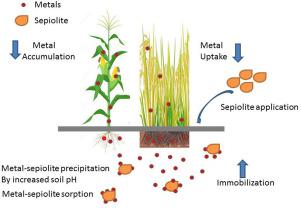Environmental Technology & Innovation ( IF 7.1 ) Pub Date : 2021-05-08 , DOI: 10.1016/j.eti.2021.101598 Yasir Hamid , Lin Tang , Bilal Hussain , Muhammad Usman , Lei Liu , Zaid Ulhassan , Zhenli He , Xiaoe Yang

|
High reactivity, reliable properties and positive environmental impacts of sepiolite clay in environment make it an important adsorbent for soil and water applications. Present review critically evaluates the applications of sepiolite in contaminated soils to adsorb toxic metals with an emphasis on cadmium (Cd) and lead (Pb). Research data has been compiled from about 140 publications reporting lab simulation studies, greenhouse experiments, and field trials. First section of this review describes the properties of sepiolite due to their role in dictating the efficiency of this mineral. In the next sections, we evaluate research advancements on the use of sepiolite for soil decontamination with a brief description about the underlying mechanisms. The properties and remediation efficiency of sepiolite can be tuned by its modification by physical or chemical strategies. In addition to its prominent metal adsorption capacity, sepiolite has the potential to increase soil pH which reduces the metal availability in soils and uptake by plants. The impacts of sepiolite on soil properties and plant growth are illustrated in soil–plant system. This extensive review highlights the strong remediation potential of sepiolite in metal-contaminated soils and positive impacts on soil–plant systems. Future studies need to focus on finding suitable methods to modify sepiolite and to explore its use in composite amendments for an improved efficiency under field conditions.
中文翻译:

海泡石粘土:综述其在污染土壤中固定有毒金属的应用及其对土壤-植物系统的影响
海泡石粘土的高反应活性,可靠的性能以及对环境的积极影响,使其成为土壤和水应用的重要吸附剂。目前的审查严格评估海泡石在受污染的土壤中吸附有毒金属的应用,重点是镉(Cd)和铅(Pb)。研究数据已从约140个出版物中收集,这些出版物报告了实验室模拟研究,温室实验和田间试验。本文的第一部分描述了海泡石的性质,因为海泡石具有决定这种矿物效率的作用。在接下来的部分中,我们将对海泡石用于土壤净化的研究进展进行评估,并简要介绍其潜在机理。海泡石的性质和修复效率可通过物理或化学方法对其进行修饰来调整。除了突出的金属吸附能力外,海泡石还具有提高土壤pH值的潜力,这会降低土壤中金属的利用率和植物的吸收能力。海泡石对土壤特性和植物生长的影响在土壤-植物系统中得到了说明。这项广泛的综述强调了海泡石在金属污染土壤中的强大修复潜力以及对土壤-植物系统的积极影响。未来的研究需要集中在寻找合适的方法来修饰海泡石,并探索其在复合修正剂中的使用,以提高田间条件下的效率。海泡石具有增加土壤pH值的潜力,这会降低土壤中金属的利用率和植物的吸收量。海泡石对土壤特性和植物生长的影响在土壤-植物系统中得到了说明。这项广泛的综述强调了海泡石在金属污染土壤中的强大修复潜力以及对土壤-植物系统的积极影响。未来的研究需要集中在寻找合适的方法来修饰海泡石,并探索其在复合修正剂中的使用,以提高田间条件下的效率。海泡石具有增加土壤pH值的潜力,这会降低土壤中金属的利用率和植物的吸收量。海泡石对土壤特性和植物生长的影响在土壤-植物系统中得到了说明。这项广泛的综述强调了海泡石在金属污染土壤中的强大修复潜力以及对土壤-植物系统的积极影响。未来的研究需要集中在寻找合适的方法来修饰海泡石,并探索其在复合修正剂中的使用,以提高田间条件下的效率。



























 京公网安备 11010802027423号
京公网安备 11010802027423号